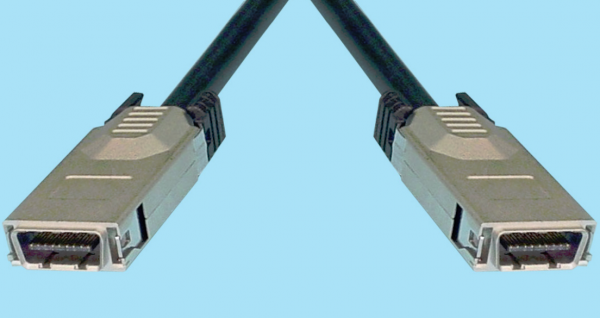英伟达(Nvidia)表示,MetroX-3长距离系统的推出后,用户现在可以将他们的400Gbps InfiniBand网络扩展到更远的地方,因此Quantum-2交换机的范围可提升到25英里或40千米。
英伟达(Nvidia)表示,MetroX-3长距离系统的推出后,用户现在可以将他们的400Gbps InfiniBand网络扩展到更远的地方,因此Quantum-2交换机的范围可提升到25英里或40千米。

Nvidia sees two major use cases for the tech: the first is high-speed workload migration between physically disparate computing centers, while the other involves pooling those resources to tackle larger problems.
Nvidia认为MetroX-3技术主要为两个用例,第一个是不同的实体计算中心之间高速工作负载的迁移,另一个用例涉及到用这些资源解决更大的问题。
While it's been possible to interconnect two datacenters over InfiniBand in the past using the MetroX-2 platform acquired from Mellanox, the appliance was limited to a pair of 100Gbps uplinks. By comparison, the third iteration of Nvidia's MetroX platform adds support for a pair of 100Gbps dense wave division multiplex (DWDM) modules. The technology allows for substantially higher bandwidths by muxing multiple 100Gbps signals onto a single fiber.
Nvidia从Mellanox收购的MetroX-2平台之前也可以通过InfiniBand将两个数据中心互连,但MetroX-2设备仅限于两个100Gbps的上行链路。而相比之下,Nvidia MetroX 3平台增加了对两个100Gbps密集波分复用(DWDM)模块的支持。MetroX 3技术将多个100Gbps信号复用到单一光纤上,可以大幅提高带宽。
"This really allows your extended campus clusters and your core datacenter to behave as a single-unit — a single datacenter," Dion Harris, head of datacenter product marketing at Nvidia, said during a press briefing.
Nvidia数据中心产品营销主管Dion Harris在新闻发布会上表示,“这确实可以让你的扩展园区集群和你的核心数据中心成为一体,成为一个单一的数据中心。”
The approach isn't without compromise. MetroX-3 is clearly an ecosystem play. It's designed to work with Nvidia's InfiniBand ecosystem of Quantum-2 switches, ConnectX-7 NICs, and/or BlueField data processing units (DPUs). That means if you're already using something like HPE's Ethernet-based Slingshot interconnects or even Nvidia's own Spectrum switches, MetroX-3 isn't for you.
这种方法也并非不用在其他方面做出让步。MetroX-3显然是和生态系统挂上了钩。MetroX-3的设计采用了Nvidia的InfiniBand生态系统Quantum-2交换机、ConnectX-7网卡和BlueField数据处理单元(DPU)。这意味着,假如你已经在用HPE的基于以太网的Slingshot互连甚至Nvidia自己的Spectrum交换机,MetroX-3就不能为你所用了。
Assuming you do live within Nvidia's walled garden, or want to expand an existing InfiniBand environment to a new location, there are also performance concessions that need to be taken into account. While DWDM allows for massive aggregate bandwidths over a single fiber, the technology is limited to relatively short runs in the neighborhood of 40 to 80 kilometers. As is typical with optics, what you gain in distance you give up on effective bandwidth and vice versa.
假设你确实用的是Nvidia的东西,或者想把现有的InfiniBand环境扩展到一个新的地点,那也需要考虑性能方面的问题。虽然DWDM允许在单一光纤上实现巨大的聚合带宽,但该技术仅限于40至80公里左右的相对较短的距离。这是个典型的光学技术,你在距离上获得好处就要放弃有效带宽,反之亦然。
The move to DWDM does present a cost advantage. According to Dell'Oro analyst Jimmy Yu, the more you be can pack onto a single fiber strand, the less you need to spend on fiber leases to achieve a given amount of bandwidth.
迁移到DWDM确实会带来成本优势。根据Dell'Oro公司分析师Jimmy Yu的说法,在一根光纤上装的东西越多,为实现一定数量的带宽所需的光纤租赁费用就越少。
And because DWDM is already widely employed by major telcos AT&T and Lumen Technology, Nvidia says customers can now tap into existing fiber infrastructures, rather than needing dedicated fiber connectivity.
而且,由于主要的电信公司AT&T和Lumen Technology已经广泛采用DWDM,Nvidia称客户现在可以利用现有的光纤基础设施,而不需要专门的光纤连接。
### Cutting through the noise
过滤喧嚣
MetroX-3 is part of a broader suite of hardware and software announced by Nvidia at the Supercomputing event this week aimed at addressing the growing volume of streaming data at the edge.
Nvidia在本周的超级计算活动中宣布推出一套更广泛的硬件和软件,旨在应付边缘上日益增长的流媒体数据量,MetroX-3是其一部分。
"By creating more high-fidelity research and instrumentation, that means that you're going to have to have a much more efficient way of capturing, analyzing and processing that data," Harris said. When "you're producing 50 to 1,000 times more data, how much do you keep? How much do you move back to the core? How much do you analyze."
Harris表示,“创建了更多的高保真研究和仪器,意味着你必须拥有更有效的方法去捕获、分析和处理这些数据。当你生成了50到1000倍的数据,你要保留多少呢?有多少要迁移到核心?要分析多少才合适呢?”
In addition to connecting datacenters over InfiniBand, Nvidia is positioning MetroX-3, along with its Quantum-series switches and BlueField DPUs, as a means to extend InfiniBand networks to lab environments where the bulk of data is being generated. By doing so, the company says customers can use its Holoscan HPC framework running on IGX, DGX or HGX platforms at the edge to sift out meaningful data from the noise before funneling that refined dataset back to the core datacenter.
Nvidia除了用MetroX-3通过InfiniBand连接数据中心外,还将MetroX-3以及旗下的Quantum系列交换机和BlueField DPU定位为利用InfiniBand网络扩展那些产生大量数据实验室环境的一种手段。Nvidia表示,这样做以后,客户可以利用其在边缘的IGX、DGX或HGX平台上运行的Holoscan HPC框架,从噪音中筛选出有意义的数据,然后再将这些精炼过的数据集输送到核心数据中心。
Initially launched alongside Nvidia's IGX robotics and edge compute platform this fall, Holoscan AI inference was for medical imaging. However, the platform has since been repurposed for use on a variety of streaming data formats including non-image formats. Holoscan has also been reworked to support C++ and Python APIs, which Nvidia says researchers can use to develop custom data pipelines around their workflows. ®
Holoscan人工智能推断是在今年秋天与Nvidia的IGX机器人和边缘计算平台一起推出的,最初主要用于医学成像。但Holoscan人工智能推断平台后来改变了用途,改为用于各种流媒体数据格式,包括非图像格式。Holoscan的源码也重新写过,现在可以支持C++和Python应用程序接口。Nvidia表示,研究人员可以利用这些应用程序接口开发涉及到各自工作流程的定制数据管道。








